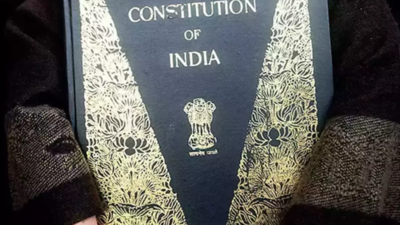- News
- Education News
- Learning with TOI News
- 10 things every student should know about the Constitution of India
Trending
This story is from November 26, 2023
10 things every student should know about the Constitution of India
The Constitution of India, a cornerstone of democracy, holds vital aspects for students: historical context, comprehensive nature, constituent assembly's role, separation of powers, fundamental rights and duties, amendment procedure, federalism, judiciary's role, directive principles, and the guiding preamble—forming a roadmap for civic engagement and responsible citizenship.

Representational
The Constitution of India, an embodiment of the nation's ethos, holds profound significance in shaping the country's governance and societal fabric. For students navigating the intricate landscape of constitutional law and civic understanding, here are 10 essential aspects to know.
Historical Context: Seeds of Sovereignty
The roots of the Indian Constitution trace back to a tumultuous era of colonialism, struggles for independence, and the collective vision of leaders like Dr.B.R. Ambedkar and Jawaharlal Nehru. It's crucial for students to grasp this historical backdrop to appreciate the monumental task of drafting a democratic framework that reflects India's diverse cultural, social, and economic landscapes.
Lengthiest Written Constitution: Comprehensive Framework
Constituent Assembly: Architects of Democracy
The Constituent Assembly, consisting of stalwarts from diverse backgrounds, painstakingly deliberated and debated to give shape to the Constitution. Their foresight and debates captured in the Constituent Assembly debates provide invaluable insights into the rationale behind various constitutional provisions, offering students a peek into the minds of the nation's founding architects.
Separation of Powers: Checks and Balances
The Indian Constitution espouses the doctrine of the separation of powers among the legislature, executive, and judiciary, ensuring a system of checks and balances. This foundational principle prevents the concentration of power in any one branch, fostering accountability and preventing abuse of authority—an essential concept for students to comprehend in understanding the functioning of the government.
Unique Blend of Fundamental Rights and Duties: Rights with Responsibility
The Constitution of India grants citizens fundamental rights, essential for their growth and dignity, while also emphasizing fundamental duties. Balancing rights with responsibilities instills a sense of civic consciousness among students, urging them to contribute positively to society while safeguarding their liberties.
Amendment Procedure: Balancing Continuity and Change
The amendment process, delineated in the Constitution, allows for necessary adaptations without compromising its core principles. Students must understand this process, as it embodies the Constitution's flexibility to evolve with changing times while upholding its fundamental values.
Federalism and Center-State Relations: Complex Governance Structure
India's federal structure, with a delicate balance between the Union and State governments, is pivotal to its governance. The Constitution allocates powers through different lists, defining the spheres of authority between the Centre and the States. Students delving into this aspect gain insight into India's complex administrative machinery.
Role of Judiciary: Guardian of Rights
The Indian judiciary, with the Supreme Court at its apex, plays a crucial role in upholding the Constitution. Understanding the judiciary's power of judicial review and its role as the guardian of fundamental rights equips students to appreciate the pivotal role it plays in ensuring justice and constitutional supremacy.
Directive Principles of State Policy: Social Welfare Blueprint
The Directive Principles of State Policy serve as a guide for governance, emphasizing socio-economic justice and welfare. Although not legally enforceable, they outline the state's duty to strive towards creating an equitable society, providing students with insights into the state's obligations beyond fundamental rights.
Preamble: Heartbeat of the Constitution
The Preamble encapsulates the spirit and essence of the Constitution, articulating the aspirations and ideals of the Indian polity. It serves as a guiding light, embodying justice, liberty, equality, and fraternity—fundamental values for students to cherish and uphold.
A comprehensive understanding of the Constitution empowers students to become active and responsible citizens. It's not merely a legal document but a living testament to India's democratic spirit, fostering a sense of duty, awareness, and engagement with the country's democratic processes.
Historical Context: Seeds of Sovereignty
The roots of the Indian Constitution trace back to a tumultuous era of colonialism, struggles for independence, and the collective vision of leaders like Dr.B.R. Ambedkar and Jawaharlal Nehru. It's crucial for students to grasp this historical backdrop to appreciate the monumental task of drafting a democratic framework that reflects India's diverse cultural, social, and economic landscapes.
Lengthiest Written Constitution: Comprehensive Framework
The Indian Constitution stands as one of the world's lengthiest written constitutions, comprising a detailed framework with 448 articles, divided into 25 parts, and further supplemented by schedules and amendments. Understanding its comprehensive nature aids students in recognizing the depth and breadth of laws governing various aspects of public life.
Constituent Assembly: Architects of Democracy
The Constituent Assembly, consisting of stalwarts from diverse backgrounds, painstakingly deliberated and debated to give shape to the Constitution. Their foresight and debates captured in the Constituent Assembly debates provide invaluable insights into the rationale behind various constitutional provisions, offering students a peek into the minds of the nation's founding architects.
Separation of Powers: Checks and Balances
The Indian Constitution espouses the doctrine of the separation of powers among the legislature, executive, and judiciary, ensuring a system of checks and balances. This foundational principle prevents the concentration of power in any one branch, fostering accountability and preventing abuse of authority—an essential concept for students to comprehend in understanding the functioning of the government.
Unique Blend of Fundamental Rights and Duties: Rights with Responsibility
The Constitution of India grants citizens fundamental rights, essential for their growth and dignity, while also emphasizing fundamental duties. Balancing rights with responsibilities instills a sense of civic consciousness among students, urging them to contribute positively to society while safeguarding their liberties.
Amendment Procedure: Balancing Continuity and Change
The amendment process, delineated in the Constitution, allows for necessary adaptations without compromising its core principles. Students must understand this process, as it embodies the Constitution's flexibility to evolve with changing times while upholding its fundamental values.
Federalism and Center-State Relations: Complex Governance Structure
India's federal structure, with a delicate balance between the Union and State governments, is pivotal to its governance. The Constitution allocates powers through different lists, defining the spheres of authority between the Centre and the States. Students delving into this aspect gain insight into India's complex administrative machinery.
Role of Judiciary: Guardian of Rights
The Indian judiciary, with the Supreme Court at its apex, plays a crucial role in upholding the Constitution. Understanding the judiciary's power of judicial review and its role as the guardian of fundamental rights equips students to appreciate the pivotal role it plays in ensuring justice and constitutional supremacy.
Directive Principles of State Policy: Social Welfare Blueprint
The Directive Principles of State Policy serve as a guide for governance, emphasizing socio-economic justice and welfare. Although not legally enforceable, they outline the state's duty to strive towards creating an equitable society, providing students with insights into the state's obligations beyond fundamental rights.
Preamble: Heartbeat of the Constitution
The Preamble encapsulates the spirit and essence of the Constitution, articulating the aspirations and ideals of the Indian polity. It serves as a guiding light, embodying justice, liberty, equality, and fraternity—fundamental values for students to cherish and uphold.
A comprehensive understanding of the Constitution empowers students to become active and responsible citizens. It's not merely a legal document but a living testament to India's democratic spirit, fostering a sense of duty, awareness, and engagement with the country's democratic processes.
End of Article
FOLLOW US ON SOCIAL MEDIA










